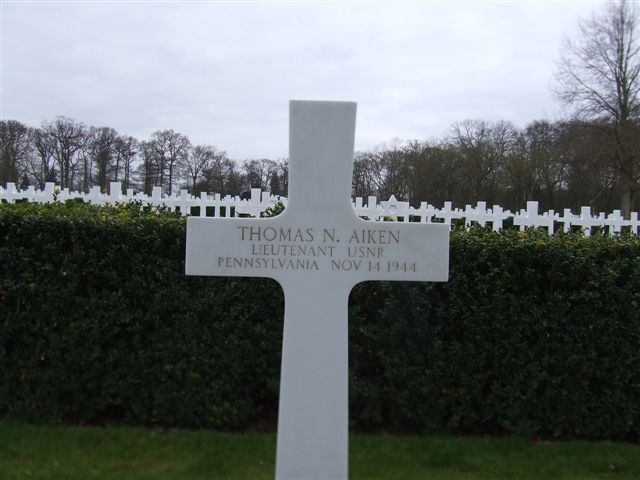Thomas Newkirk Aiken was born on April 23, 1909, in Ardmore, Montgomery County, Pennsylvania. Thomas entered the service from Pennsylvania. Tom had been educated near his home at the Museum School of Industrial Art. He enlisted as an air gunner from 3rd February 1941 until March 31st, 1943 when he became a junior grade Lieutenant. He fought the Japanese from the aircraft carrier, USS Essex and his service won him the Air Medal, the Gold Star in place of a second Air Medal, and the Purple Heart. In early 1944 he was selected for night-fighter training with the RAF by which time he had been promoted to full Lieutenant.
Thomas was a Navigator in the United States Naval Air Force and was killed, together with Pilot, Lieutenant Joseph Francis Black whilst returning from operational duties. They observed an air-launched V1 Flying Bomb and gave chase when their de Havilland Mosquito night fighter was shot down by friendly fire from an anti-aircraft battery. Their plane crashed in the Suffolk countryside near Somerleyton. By autumn 1944 the allied forces in Western Europe had destroyed all the launch areas for the German V1 flying bombs. The Luftwaffe then began a program of air-borne launching of the missiles.
Thomas and Joe were part of a ten-man group of US Navy airmen who gathered together on 1st July 1944 at USN Forces HQ in London for training and eventual transfer to the Pacific theatre to combat Japanese night-fighters. Only four of this group were to survive the war. From London, the group transferred to the No.51 Operational Training Unit at RAF Cranfield in Bedfordshire. At the time of his death, the squadron had only recently moved to RAF Coltishall, Norfolk. The Mosquito was described as Britain's "Wooden Wonder"-it featured two Rolls-Royce Merlin engines and was constructed of plywood and balsa wood. His Mosquito was named/numbered "K-King, HK 289.
Lt. Aiken is now buried in the Cambridge American Cemetery, Cambridge, United Kingdom.
Source of information: www.findagrave.com

